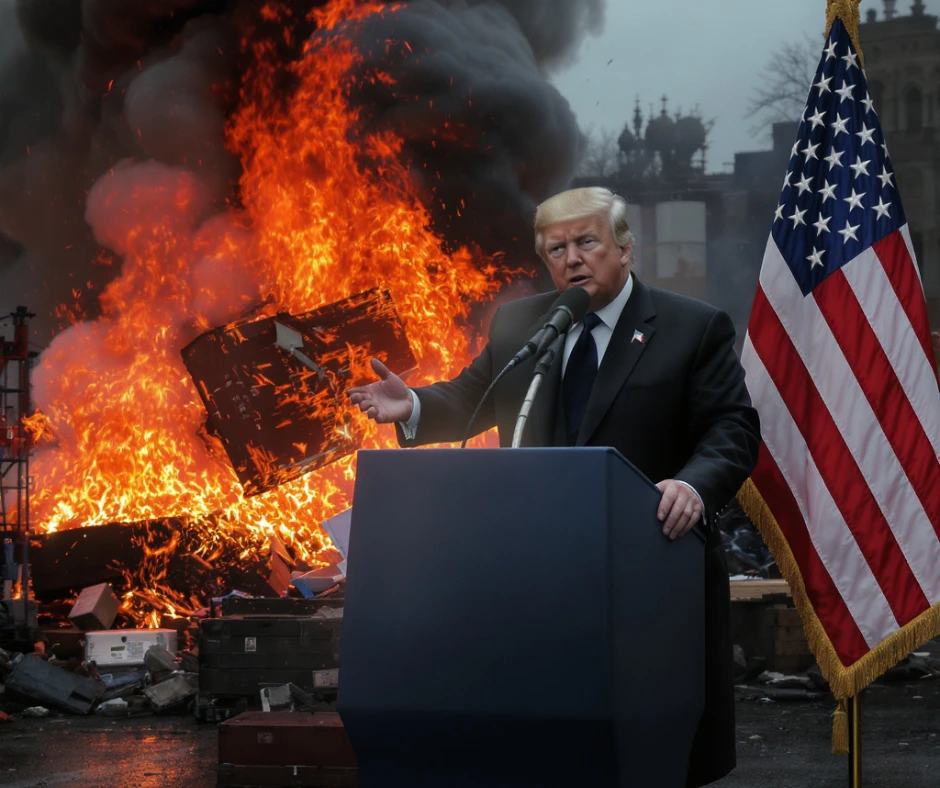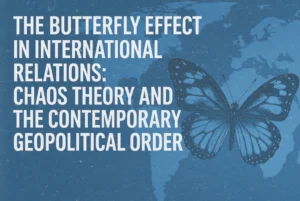Chaos Theory, with its fundamental principle of the “butterfly effect,”...
Read MoreTable of Contents
The Butterfly Effect in International Relations: Chaos Theory and the Reconfiguration of the Contemporary Geopolitical Order
Abstract:
Chaos Theory, with its fundamental principle of the “butterfly effect,” proposes that small initial changes in a system can generate significant and unpredictable impacts over time. This article analyzes how this theory can be applied to the context of contemporary International Relations, examining historical events such as the Defenestration of Prague and recent phenomena such as U.S. trade policies under the leadership of Donald Trump. The text also discusses the rise of new economic blocs, the weakening of U.S. hegemony, and the contemporary relevance of the principles of the Treaty of Westphalia (1648). In a constantly transforming global scenario, Chaos Theory emerges as a useful interpretive lens to understand today’s complex and interconnected geopolitical dynamics.
Introduction
Chaos Theory, often associated with the concept of the “butterfly effect,” establishes that small alterations in initial conditions can generate disproportionate consequences in complex systems. Although its name may suggest disorder, the theory holds that such systems follow an internal logic highly sensitive to starting conditions, suggesting that nothing happens by chance. This approach finds a direct analogy in the evolution of geopolitical relations, where local and seemingly isolated events can trigger profound global transformations.
The Butterfly Effect and the Defenestration of Prague: A Historical Example
On May 23, 1618, the so-called Defenestration of Prague-when two Catholic representatives of the Holy Roman Emperor were thrown out the window of Prague Castle-served as the immediate trigger for the Thirty Years’ War (1618–1648). This punctual event sparked a conflict that spread across Europe, resulting in the deaths of approximately 8 million people, significant shifts in the continental balance of power, and ultimately the signing of the Treaty of Westphalia, a landmark in the foundation of the modern international system. This historical example clearly illustrates how a small initial event can become a continental-scale turning point.
Chaos Theory as a Modern Geopolitical Strategy
Today, the concept of chaos has been instrumentalized as a political strategy. Powerful countries, such as the United States-particularly under Donald Trump’s administration-have used instability as a tool of foreign policy. The imposition of tariffs, threats of military intervention, and destabilization of governments in rapidly developing countries were ways of provoking “small” disturbances with the aim of generating large consequences, forcing nations to submit to agreements aligned with the hegemonic interests of the Global North.

Comparative Advantage in Times of Trade War
The Theory of Comparative Advantage, as discussed by Paul Krugman and other economists, asserts that no country is self-sufficient in terms of production. The U.S. attempt to internalize goods such as orange juice—whose tropical production is far more efficient in countries like Brazil-highlights the disproportionate costs of ignoring this economic logic. The increase in tariffs on foreign products led to higher domestic prices, production inefficiencies, and, paradoxically, a loss of international competitiveness.
The Reconfiguration of the World Order: Alternative Blocs and Multilateralism
While the U.S. pursued protectionist and unilateral policies, the rest of the world began to reorganize around new centers of power and multilateral integration. Examples include:
BRICS+: An economic and financial coalition offering alternatives to the IMF and World Bank, bringing together countries such as Brazil, Russia, China, India, South Africa, the United Arab Emirates, Egypt, Saudi Arabia, Ethiopia, Indonesia, and Iran.
COMESA: The Common Market for Eastern and Southern Africa, strengthening intraregional trade among 21 African nations.
RCEP: The Regional Comprehensive Economic Partnership, composed of 15 Asia-Pacific countries, including China, Japan, and Australia, promoting a new dynamic of Asian cooperation.
This reorganization demonstrates a growing resistance to unipolar domination and a renewed commitment to multilateralism and national sovereignty.
The Return of Westphalian Principles in Contemporary Times
The Treaty of Westphalia, by establishing the principles of national sovereignty and non-intervention, proves increasingly relevant in a world where former powers attempt to impose their influence through chaos. Attempts to reinstate the logic of the Bretton Woods Agreement (1944) – making all economies dependent on the dollar and Western financial systems-have been challenged by new economic and diplomatic alliances. The resistance of countries such as Brazil, Canada, Mexico, China, and the BRICS+ members highlights a growing pursuit of strategic and economic autonomy.
Final Considerations
International Relations are, by definition, a chaotic system, highly sensitive to local disruptions and specific political decisions. Attempts to manipulate this chaos for strategic purposes do not always succeed, as shown by the decline of U.S. influence in recent years. Conversely, the world has been adopting a more collaborative and decentralized stance, strengthening regional alliances and respecting the principles of sovereignty and self-determination. Chaos Theory, therefore, provides a robust analytical framework for understanding both the risks and opportunities of contemporary geopolitics.
References
Lorenz, E. N. (1963). Deterministic Nonperiodic Flow. Journal of the Atmospheric Sciences.
Krugman, P. (1991). Geography and Trade. MIT Press.
Tilly, C. (1992). Coercion, Capital, and European States. Blackwell.
Kissinger, H. (1994). Diplomacy. Simon & Schuster.
Treaty of Westphalia (1648). International Historical Archive.
Share With Your Network
How to Start a Business
Brazil is full of opportunity — but bureaucracy can be...
Read MoreWhy Your Business Needs a
A temporary fiscal address is an officially registered location that...
Read MoreHow Chinese SMEs Can Benefit
The China-Brazil currency swap agreement offers a strategic advantage for...
Read More




